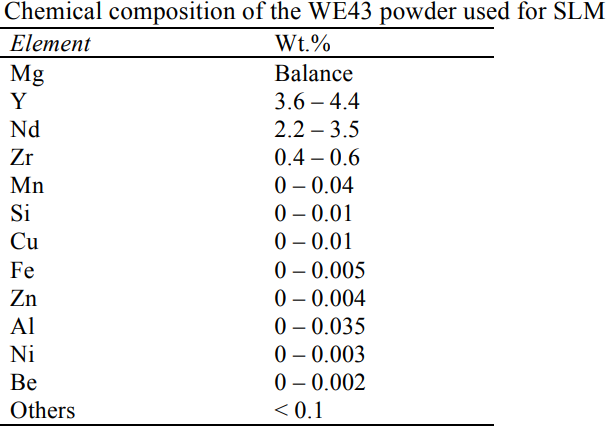Researchers have come together from around the world to analyze 3D printing materials, outlining their findings in ‘A detailed microstructural and corrosion analysis of an additively manufactured magnesium alloy produced by selective laser melting.’
As the merits of 3D printing, additive manufacturing—particularly with metal—continue to offer advantages in a wide range of industries from automotive to aerospace to medical, a lucrative market is emerging for software, hardware, and materials. The authors quote projected revenues of over $11 billion by 2024, with popularity increasing for metals such as:
- Stainless steels
- Nickel
- Alloys
- Titanium
- Aluminum
A variety of different alloys have captivated the interest of users on the research and manufacturing levels, due to properties such as strength, light weight, and recyclability.
“Although there exists a plethora of studies on the processing, microstructure and physical properties of Mg-based alloys (see e.g., [9-17]), to date, there remains a limited reporting, characterization and rationalization of processing-structure-properties relationships for AM produced Mg alloys [18-20],” explained the researchers.
“In part this is because the production of Mg-based alloys by AM has been considered complicated, owing to a range of factors that could include: safety concerns associated with the reactive nature of Mg powder; the superheating and boiling / evaporation of Mg via interaction with laser based methods; a tendency for ignition in the presence of common environments (Mg can burn under air or N2), and even supply chain issues for Mg powder of suitable size and composition (relevant to powder based AM).”
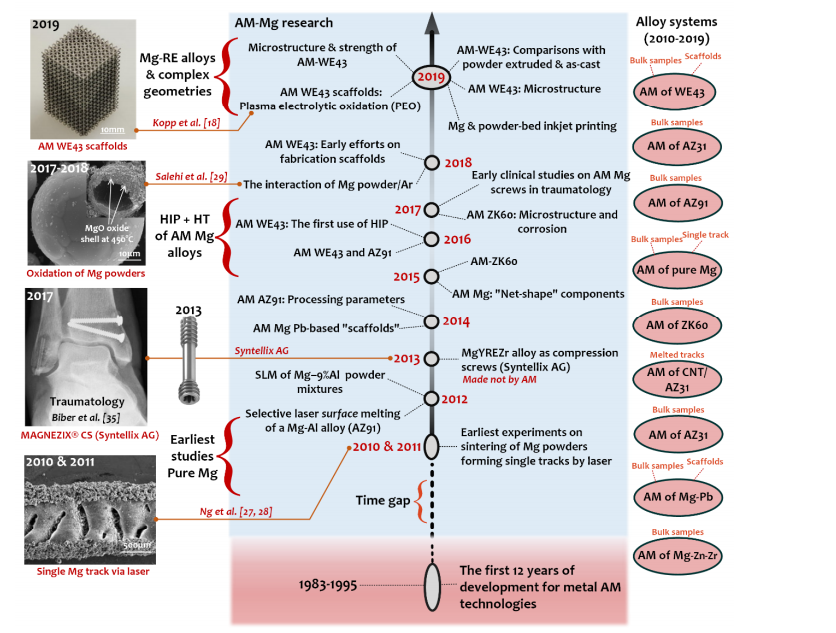
Timeline displaying a historical background of AM-Mg research and development, indicating “landmarks” since the first scientific study on utilisation of AM to sinter Mg powder, from [18-29, 33-38]. The images shown in the left-hand side were reproduced with permission from Elsevier. Note the difference in the geometrical complexity that can be accomplished by AM (i.e., the scaffold) as compared to other state-of-the-art manufacturing technologies (i.e., the compression screw)
Selective laser melting (SLM) was chosen as the technique for 3D printing specimens, with the build chamber flooded with pure inert argon as well as housing a gas circulation system meant to prevent oxidation and metal vapor.
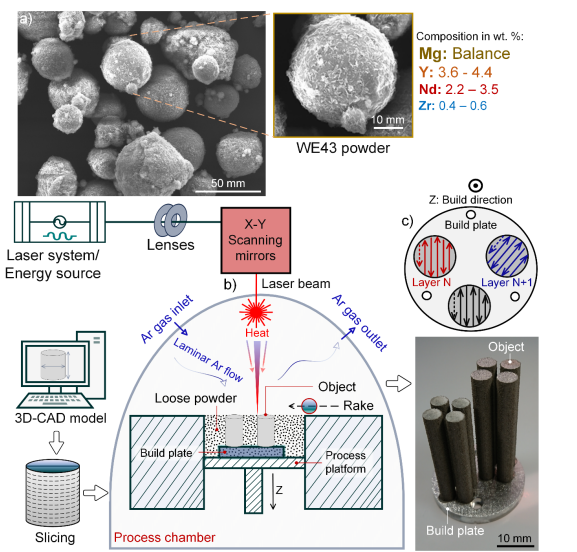
(a) The characteristic morphology of the WE43 powder and its nominal chemical composition used for SLM, (b) a schematic of the SLM process used in this study and the cylindrical samples manufactured by SLM, and (c) the scanning strategy used in this study.
“The process parameters were optimized in terms of the specimen quality (which was user-defined to include density, dimensional accuracy, mechanical properties and evaporation of Mg powder). Cylindrical test specimens for the microstructural and corrosion investigations were prepared with a diameter of 6 mm and height of 30 mm,” stated the researchers.
Optimizing process parameters was not the focus of this research; however, as the authors stressed, such an exercise is still extremely important to noting critical properties. Also noted, as samples were fabricated in the ‘low energy input zone,’ mechanical strength was considerably inferior; conversely, when samples were produced in the high-energy zone, there was evaporation due to low boiling point at 1090°C.
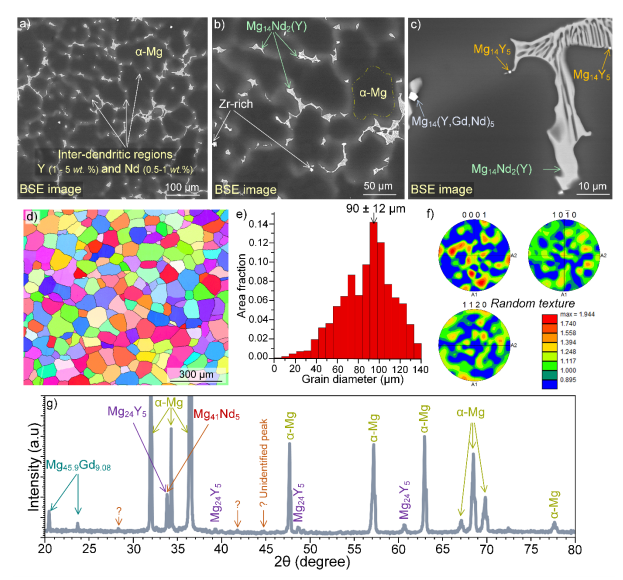
(a-c) BSE-SEM micrographs revealing the typical microstructure of cast WE43 (the phases designated in Figs. 4a-c were identified using EDXS), (d-f) EBSD analysis revealing the grain structure and the random texture of the alloy, and (g) XRD spectra showing the phases in WE43.
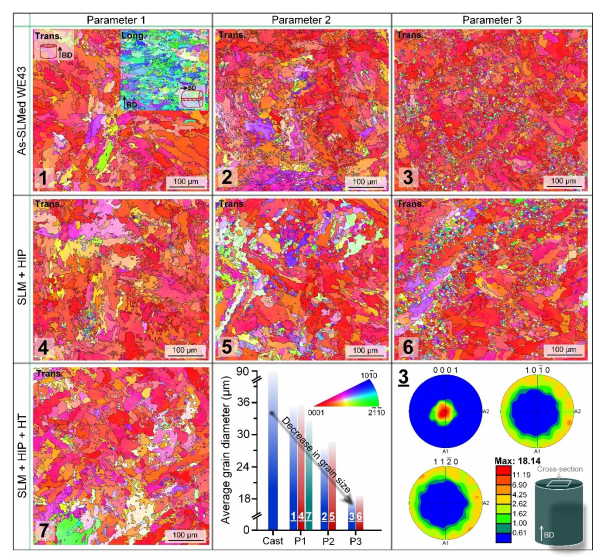
EBSD analysis of the samples in the as-SLMed, SLM + HIP and SLM + HIP + HT conditions. The figure also includes an example of pole figures corresponding to the EBSD map of SLM prepared sample fabricated using Parameter 3 (Map 3) exemplifying the strong basal texture of all SLM prepared WE43. The samples were extracted near top surface with 5 mm distance from top of the cylinders.
“Under proper laser parameters (P =300 W and v = 1200 mm/s), the SLM prepared WE43 was found to exhibit a negligible fraction of metallurgical and process-induced defects. It was also noted that HIP treatment (at 520°C, 103 MPa for 4 h) is an effective approach to eliminate the process-induced defects, thus achieving an (nearly) fully dense specimens. 2. The SLM prepared WE43 exhibited a substantially different microstructure relative to cast WE43. As the principal microstructural feature, a high density of fine oxide flakes rich in Y and Nd were observed to distribute uniformly in the microstructure of the SLM prepared alloys (in all conditions),” concluded the researchers. “It was proposed that the rather pronounced re-distribution of Zr and Y can be considered accountable for the enhanced cathodic activity of the SLM prepared WE43.
“The strong affinities of Y and Zr for oxygen promote the formation of oxides during powdersiation. The two next critical research directions which merit important work in the future include designing new alloy chemistries explicitly suited for SLM (to retard the cathodic kinetics upon the Mg-rich matrix) as well as modifying the powderisation process that could supress oxidation of alloy powder during atomisation.”
What do you think of this news? Let us know your thoughts! Join the discussion of this and other 3D printing topics at 3DPrintBoard.com.
[Source / Images: ‘A detailed microstructural and corrosion analysis of an additively manufactured magnesium alloy produced by selective laser melting’]Subscribe to Our Email Newsletter
Stay up-to-date on all the latest news from the 3D printing industry and receive information and offers from third party vendors.
You May Also Like
3D Printing Unpeeled: New Arkema Material for HP, Saddle and Macro MEMS
A new Arkema material for MJF is said to reduce costs per part by up to 25% and have an 85% reusability ratio. HP 3D HR PA 12 S has been...
3D Printing News Briefs, January 20, 2024: FDM, LPBF, Underwater 3D Printer, Racing, & More
We’re starting off with a process certification in today’s 3D Printing News Briefs, and then moving on to research about solute trapping, laser powder bed fusion, and then moving on...
3D Printing Webinar and Event Roundup: December 3, 2023
We’ve got plenty of events and webinars coming up for you this week! Quickparts is having a Manufacturing Roadshow, America Makes is holding a Member Town Hall, Stratafest makes two...
Formnext 2023 Day Three: Slam Dunk
I’m high—high on trade show. I’ve met numerous new faces and reconnected with old friends, creating an absolutely wonderful atmosphere. The excitement is palpable over several emerging developments. The high...


